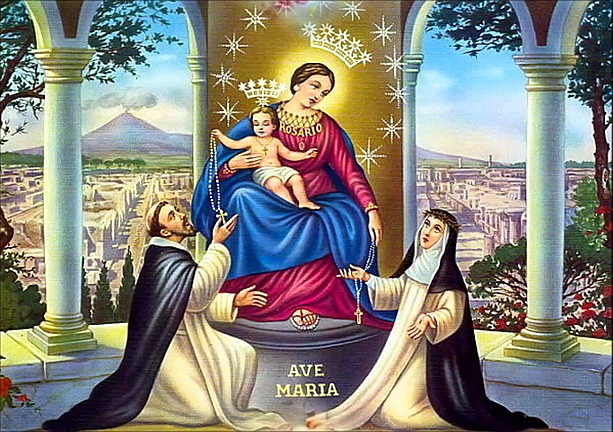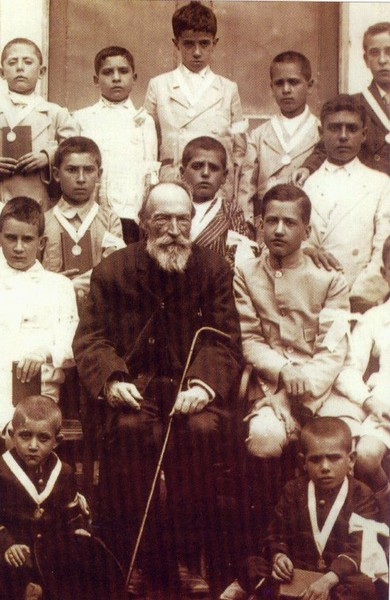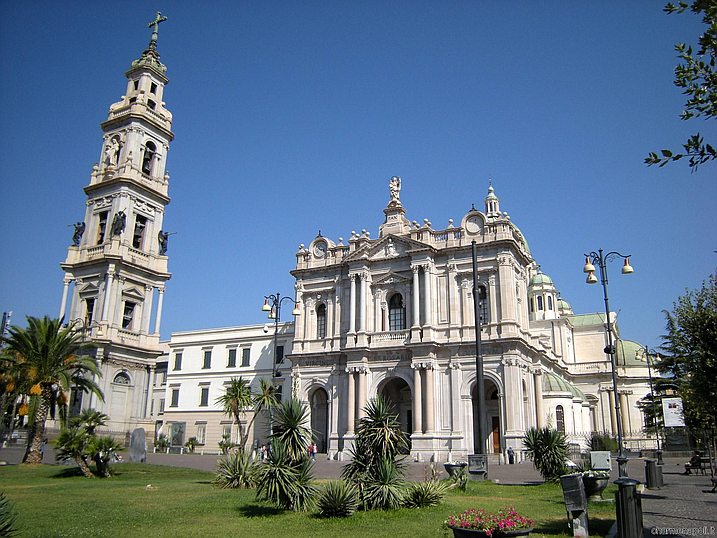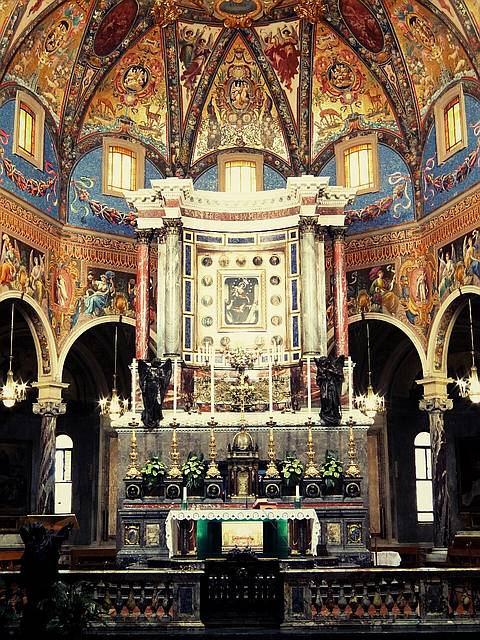

Pompeii was a great and prosperous city in Roman times until it was destroyed by an eruption of Mount Vesuvius in 79 AD.
It was nearly 1800 years later when a certain man named Bartolo Longo went there to attend to property owned by his wife, the Countess
of Fusco. The region was described in the official records as a most dangerous resort of bold and infamous robbers.
Bartolo Longo had been raised and educated as a Catholic, but he went through a crisis of faith during his university years,
as he studied to become a lawyer. This comes as no surprise as we now know that Marxists and Freemasons were actively infiltrating the
faculties of universities even in the 19th century. Bartolo became involved with spiritualism – some say he even became a
priest of Satan.
He publicly ridiculed Christianity and did all in his power to subvert Catholic influence.
Thanks, however, to the zeal of a good Catholic friend and a devout Dominican priest, he was introduced to the devotion of the
Holy Rosary. He began to change his attitude, and to look upon Our Lady as the Refuge of Sinners. He began to form a good
resolution to amend his life, do penance for his past, and to be of some service to the poor.
But when Bartolo arrived, in October of 1872, at the marshy, impoverished Pompeii, accompanied by two bodyguards, he was appalled by what he saw. There was only one chapel and one parish priest for the entire region, yet this was sufficient for the few people who still went to church. Most of the inhabitants had fallen victim to superstition; fear of the evil eye was rampant.
 On October 9, Bartolo was walking through one of the most desolate parts of the desolate region. His own doubts were
assailing him again. Should he again give up the Faith in which his devout mother had raised him? Suddenly he became aware that a
voice was speaking to him:
On October 9, Bartolo was walking through one of the most desolate parts of the desolate region. His own doubts were
assailing him again. Should he again give up the Faith in which his devout mother had raised him? Suddenly he became aware that a
voice was speaking to him:
If you seek salvation, promulgate the Rosary. This is Mary's own promise.
Bartolo answered: If it be true that Thou didst promise to St. Dominic that whosever should promulgate Thy Rosary
should be saved, then shall I be saved; for I will not leave this valley until I have propagated the Rosary!
The Angelus rang
out from the distant church, and Bartolo fell to his knees to confirm his pledge.
Bartolo’s attempts to found a Rosary confraternity met with little success at first, but by 1875 he had made a promising
start. In that year the Bishop of Nola was won over. Visiting the little chapel, the Bishop said, You wish to raise an altar here
in honor of the Rosary? I propose we raise not an altar but a church!
Then pointing to a field opposite he added,
That is where a basilica will be raised for Pompeii!
Bartolo wished to find an image that would encourage the peasants in the daily recitation of the Rosary. He told the people that he would have an image for them by the time they completed a three-day mission. He found a painting of Our Lady of the Rosary which he liked, but he was very much disappointed when he learned that the picture did not meet the requirements of Canon Law. Bartolo hurried to Naples to secure another painting. He could find none that cost less than 400 francs, a price which he could not afford. What would he do? He had promised the people an image.
A friend in Naples gave him a painting which he had bought in a second-hand shop for three francs. Bartolo looked at it
with a sinking heart. It met the requirements of Canon Law, but it violated every aesthetic principle. Not only was it
worm-eaten,
Bartolo would say later, but the face of the Madonna was that of a coarse, rough country woman... a piece of
canvas was missing just above Her head... Her mantle was cracked. Nothing can be said of the hideousness of the other figures.
St. Dominic looked like a street idiot. To Our Lady's left was St. Rose. This later I had changed to St. Catherine of Siena...
I hesitated whether to refuse the gift or to accept. I had promised an image unconditionally for that evening. I took it.
The painting was too big for Bartolo to carry by hand, so he gave it to a delivery man who made regular trips between Pompeii and Naples. The painting, wrapped in a sheet, was carried to the chapel on top of a load of manure, which was to be delivered to a nearby farm. Thus it was in stark humility that Our Lady of Pompeii arrived at Her chosen shrine. For this image became the focal point of devotion at the chapel.
Bartolo bought the picture in November, 1875. In January, 1876, it was partially restored in time for the canonical foundation of the Confraternity (see home page).
Meanwhile, in Naples, Clorinda Lucarelli, a child of twelve, lay at the point of death. She was a victim of epilepsy and had been given up by the doctors. Clorinda's aunt and guardian heard of the new Rosary Confraternity and promised to help in the building of a new church if the child got well. The girl was restored to complete health on the very day the painting was re-exposed for veneration. Doctors who had examined her previously said that her recovery was not due to any medical treatment. The relatives of Concetta Vasterilla, who was dying in agony, made a similar promise to Our Lady of Pompeii. She too recovered swiftly and completely. Father Anthony Varone was cured of a fearful gangrenous malady the same day that he put his trust in Our Lady of Pompeii. All his symptoms vanished at once, and the next morning he rose to say Mass. All these cures took place in the early months of 1876.

The cornerstone of the new church was laid on May 8 of that year. Exactly a month later, Madame Giovannina Muta,
who was suffering in the last stages of consumption, appealed to Our Lady of Pompeii. As she lay in bed she saw an exact replica
of the painting in the chapel, although she had never seen the original. Our Lady gazed upon her and then threw towards her a kind
of white ribbon on which was the message: The Virgin of Pompeii grants your request, Giovannina Muta.
She was cured immediately.
The cures attributed to Our Lady of Pompeii could be extended indefinitely. There was one, however, that deserves
special mention. Fortuna Agrelli, a girl of Naples, had been ill for thirteen months. She suffered intense pain. Her father
had called in the most celebrated doctors but they had declared her incurable. On February 16, 1884, she and some of her
relatives began a novena of Rosaries. On March 3, Our Lady appeared to Fortuna as the Virgin of Pompeii. She was sitting on a
high throne, and the Infant Jesus was on Her lap. She held a rosary in Her hand. She was accompanied by St. Dominic and
St. Catherine of Siena. The throne was profusely decorated with flowers. The beauty of Our Lady was marvelous. She looked
at Fortuna with motherly tenderness. Queen of the Holy Rosary,
Fortuna exclaimed, be gracious to me; restore my health!
I have already prayed to Thee in a novena, O Mary, but have not yet experienced Thy aid. I am so anxious to be cured!
Child,
replied the Blessed Virgin, thou has invoked Me by various titles and hast always obtained favors
from Me. Now, since thou hast called Me by the title so pleasing to Me, Queen of the Holy Rosary, I can no longer refuse the
favor thou dost petition; for this name is most precious and dear to Me. Make three novenas, and thou shalt obtain all.
Fortuna obeyed, and she was cured.
 Soon after that, Our Lady appeared again. This time She said,
Soon after that, Our Lady appeared again. This time She said, Whosoever desires to obtain favors from Me should
make three novenas of the prayers of the Rosary in petition and three novenas in thanksgiving.
This was the origin of the
devotion of the Rosary Novenas to Our Lady, sometimes called the Irresistible Novena. The devotion calls for at least
five decades of the Rosary each day for 27 days in petition, followed by at least five decades a day for 27 days in thanksgiving –
54 days in all. It is a powerful form of prayer; we have Our Lady's word for it.
The new church at Pompeii was completed and then enlarged. In May, 1891, it was consecrated by Cardinal La Valette, as Papal Legate for Pope Leo XIII. A large orphanage was built beside it and a hospice for pilgrims. In 1906 Bartolo Longo, who lived to see the marvelous results for the Confraternity he had originated, deeded his property at Pompeii to the Holy See. Under the Lateran Treaty of 1929, the church and surrounding property became directly subject to the Vatican City-State. In 1934, at the command of Pope Pius XI, a new Basilica was begun on the spot that had been pointed out by the Bishop 59 years before. The Basilica was completed in 1939.
The painting from the secondhand store was enshrined in a frame of gold and encrusted with diamonds and gems, which formerly hid all but the faces of Our Lady, the Saints, and the Holy Child. Multitudes have prayed before it, beseeching Our Lady for her graces. Pilgrims were especially fervent in the trying days of World War II and during the troubled years that followed. Our Lady of Pompeii has been a great consolation to the Italians in all their troubles.
Pompeii, like the other principal manifestations of Our Lady since 1830 (e.g., the Miraculous Medal, La Salette,
Lourdes), seems a forerunner of Fatima. The Rosary is the central devotion of Pompeii, and at Fatima the Blessed Mother came
to ask us to say the Rosary every day.
The Rosary will be a most powerful weapon in restoring the world to Christ.
Contact us: smr@salvemariaregina.info
Visit also: www.marienfried.com